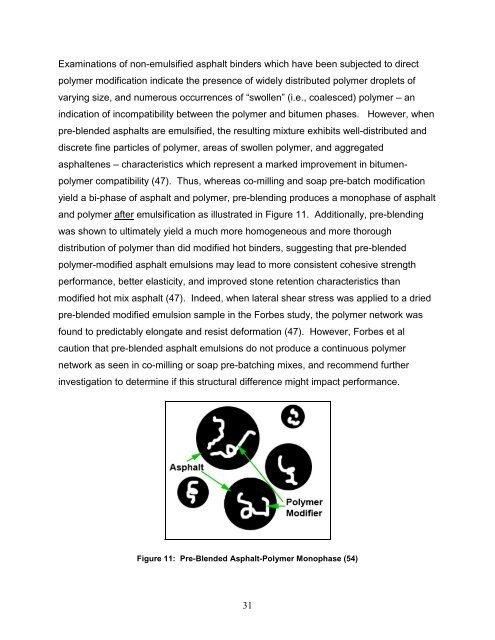Using Polymer Modified Asphalt Emulsions in Surface Treatments A ...
Using Polymer Modified Asphalt Emulsions in Surface Treatments A ...
Using Polymer Modified Asphalt Emulsions in Surface Treatments A ...
Create successful ePaper yourself
Turn your PDF publications into a flip-book with our unique Google optimized e-Paper software.
Exam<strong>in</strong>ations of non-emulsified asphalt b<strong>in</strong>ders which have been subjected to direct<br />
polymer modification <strong>in</strong>dicate the presence of widely distributed polymer droplets of<br />
vary<strong>in</strong>g size, and numerous occurrences of “swollen” (i.e., coalesced) polymer – an<br />
<strong>in</strong>dication of <strong>in</strong>compatibility between the polymer and bitumen phases. However, when<br />
pre-blended asphalts are emulsified, the result<strong>in</strong>g mixture exhibits well-distributed and<br />
discrete f<strong>in</strong>e particles of polymer, areas of swollen polymer, and aggregated<br />
asphaltenes – characteristics which represent a marked improvement <strong>in</strong> bitumenpolymer<br />
compatibility (47). Thus, whereas co-mill<strong>in</strong>g and soap pre-batch modification<br />
yield a bi-phase of asphalt and polymer, pre-blend<strong>in</strong>g produces a monophase of asphalt<br />
and polymer after emulsification as illustrated <strong>in</strong> Figure 11. Additionally, pre-blend<strong>in</strong>g<br />
was shown to ultimately yield a much more homogeneous and more thorough<br />
distribution of polymer than did modified hot b<strong>in</strong>ders, suggest<strong>in</strong>g that pre-blended<br />
polymer-modified asphalt emulsions may lead to more consistent cohesive strength<br />
performance, better elasticity, and improved stone retention characteristics than<br />
modified hot mix asphalt (47). Indeed, when lateral shear stress was applied to a dried<br />
pre-blended modified emulsion sample <strong>in</strong> the Forbes study, the polymer network was<br />
found to predictably elongate and resist deformation (47). However, Forbes et al<br />
caution that pre-blended asphalt emulsions do not produce a cont<strong>in</strong>uous polymer<br />
network as seen <strong>in</strong> co-mill<strong>in</strong>g or soap pre-batch<strong>in</strong>g mixes, and recommend further<br />
<strong>in</strong>vestigation to determ<strong>in</strong>e if this structural difference might impact performance.<br />
Figure 11: Pre-Blended <strong>Asphalt</strong>-<strong>Polymer</strong> Monophase (54)<br />
31
















